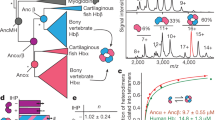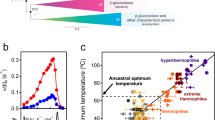Abstract
The principles of natural protein engineering are obscured by overlapping functions and complexity accumulated through natural selection and evolution. Completely artificial proteins offer a clean slate on which to define and test these protein engineering principles, while recreating and extending natural functions. Here we introduce this method with the design of an oxygen transport protein, akin to human neuroglobin. Beginning with a simple and unnatural helix-forming sequence with just three different amino acids, we assembled a four-helix bundle, positioned histidines to bis-histidine ligate haems, and exploited helical rotation and glutamate burial on haem binding to introduce distal histidine strain and facilitate O2 binding. For stable oxygen binding without haem oxidation, water is excluded by simple packing of the protein interior and loops that reduce helical-interface mobility. O2 affinities and exchange timescales match natural globins with distal histidines, with the remarkable exception that O2 binds tighter than CO.
This is a preview of subscription content, access via your institution
Access options
Subscribe to this journal
Receive 51 print issues and online access
$199.00 per year
only $3.90 per issue
Buy this article
- Purchase on Springer Link
- Instant access to full article PDF
Prices may be subject to local taxes which are calculated during checkout



Similar content being viewed by others
References
Darwin, C. Origin of Species by Means of Natural Selection, or the Preservation of Favoured Races in the Struggle for Life 6th edn (Murray, 1872)
Muller, H. J. The relation of recombination to mutational advance. Mutat. Res. 1, 2–9 (1964)
Csete, M. E. & Doyle, J. C. Reverse engineering of biological complexity. Science 295, 1664–1669 (2002)
Kraut, D. A., Carroll, K. S. & Herschlag, D. Challenges in enzyme mechanism and energetics. Annu. Rev. Biochem. 72, 517–571 (2003)
Bolon, D. N. & Mayo, S. L. Enzyme-like proteins by computational design. Proc. Natl Acad. Sci. USA 98, 14274–14279 (2001)
Jiang, L. et al. De novo computational design of retro-aldol enzymes. Science 319, 1387–1391 (2008)
Rothlisberger, D. et al. Kemp elimination catalysts by computational enzyme design. Nature 453, 190–195 (2008)
Kaplan, J. & DeGrado, W. F. De novo design of catalytic proteins. Proc. Natl Acad. Sci. USA 101, 11566–11570 (2004)
Moffet, D. A. et al. Peroxidase activity in heme proteins derived from a designed combinatorial library. J. Am. Chem. Soc. 122, 7612–7613 (2000)
Monien, B. H. et al. Detection of heme oxygenase activity in a library of four-helix bundle proteins: towards the de novo synthesis of functional heme proteins. J. Mol. Biol. 371, 739–753 (2007)
Collman, J. P., Boulatov, R., Sunderland, C. J. & Fu, L. Functional analogues of cytochrome c oxidase, myoglobin, and hemoglobin. Chem. Rev. 104, 561–588 (2004)
Jencks, W. P. Binding-energy, specificity, and enzymic catalysis – circe effect. Adv. Enzymol. 43, 219–410 (1975)
Chou, P. Y. & Fasman, G. D. Empirical predictions of protein conformation. Annu. Rev. Biochem. 47, 251–276 (1978)
Regan, L. & Degrado, W. F. Characterization of a helical protein designed from 1st principles. Science 241, 976–978 (1988)
Robertson, D. E. et al. Design and synthesis of multi-heme proteins. Nature 368, 425–431 (1994)
Gibney, B. R. et al. Iterative protein redesign. J. Am. Chem. Soc. 121, 4952–4960 (1999)
Huang, S. S. et al. X-ray structure of a maquette scaffold. J. Mol. Biol. 326, 1219–1225 (2003)
Huang, S. S. et al. The HP-1 maquette: from an apoprotein structure to a structured hemoprotein designed to promote redox-coupled proton exchange. Proc. Natl Acad. Sci. USA 101, 5536–5541 (2004)
Marshall, S. A. & Mayo, S. L. Achieving stability and conformational specificity in designed proteins via binary patterning. J. Mol. Biol. 305, 619–631 (2001)
Vallee, B. L. & Williams, R. J. P. Metalloenzymes – entatic nature of their active sites. Proc. Natl Acad. Sci. USA 59, 498–505 (1968)
Shifman, J. M. et al. Functionalized de novo designed proteins: mechanism of proton coupling to oxidation/reduction in heme protein maquettes. Biochemistry 37, 16815–16827 (1998)
Koder, R. L. et al. Native-like structure in designed four helix bundles driven by buried polar interactions. J. Am. Chem. Soc. 128, 14450–14451 (2006)
Isogai, Y. et al. Design and synthesis of a globin fold. Biochemistry 38, 7431–7443 (1999)
Gibney, B. R. et al. Self-assembly of heme A and heme B in a designed four-helix bundle: implications for a cytochrome c oxidase maquette. Biochemistry 39, 11041–11049 (2000)
Zhuang, J. Y. et al. Design of a five-coordinate heme protein maquette: a spectroscopic model of deoxymyoglobin. Inorg. Chem. 43, 8218–8220 (2004)
Chance, B., Saronio, C. & Leigh, J. S. Functional intermediates in reaction of cytochrome-oxidase with oxygen. Proc. Natl Acad. Sci. USA 72, 1635–1640 (1975)
Shikama, K. The molecular mechanism of autoxidation for myoglobin and hemoglobin: a venerable puzzle. Chem. Rev. 98, 1357–1373 (1998)
Wang, J. H. Hemoglobin studies. 2. A synthetic material with hemoglobin-like property. J. Am. Chem. Soc. 80, 3168–3169 (1958)
Grosset, A. M. et al. Proof of principle in a de novo designed protein maquette: an allosterically regulated, charge-activated conformational switch in a tetra-alpha-helix bundle. Biochemistry 40, 5474–5487 (2001)
Trent, J. T., Hvitved, A. N. & Hargrove, M. S. A model for ligand binding to hexacoordinate hemoglobins. Biochemistry 40, 6155–6163 (2001)
Dewilde, S. et al. Biochemical characterization and ligand binding properties of neuroglobin, a novel member of the globin family. J. Biol. Chem. 276, 38949–38955 (2001)
Pesce, A. et al. Human brain neuroglobin structure reveals a distinct mode of controlling oxygen affinity. Structure 11, 1087–1095 (2003)
Peterson, E. S. et al. A comparison of functional and structural consequences of the tyrosine B10 and glutamine E7 motifs in two invertebrate hemoglobins (Ascaris suum and Lucina pectinata). Biochemistry 36, 13110–13121 (1997)
Borovik, A. S. Bioinspired hydrogen bond motifs in ligand design: the role of noncovalent interactions in metal ion mediated activation of dioxygen. Acc. Chem. Res. 38, 54–61 (2005)
Mclendon, G. Control of biological electron-transport via molecular recognition and binding – the velcro model. Struct. Bond. 75, 159–174 (1991)
Page, C. C., Moser, C. C. & Dutton, P. L. Mechanism for electron transfer within and between proteins. Curr. Opin. Chem. Biol. 7, 551–556 (2003)
Brannigan, J. A. & Wilkinson, A. J. Protein engineering 20 years on. Nature Rev. Mol. Cell Biol. 3, 964–970 (2002)
Hilvert, D. Critical analysis of antibody catalysis. Annu. Rev. Biochem. 69, 751–793 (2000)
Carbone, M. N. & Arnold, F. H. Engineering by homologous recombination: exploring sequence and function within a conserved fold. Curr. Opin. Struct. Biol. 17, 454–459 (2007)
Moser, C. C. et al. Nature of biological electron-transfer. Nature 355, 796–802 (1992)
Benkovic, S. J. & Hammes-Schiffer, S. A perspective on enzyme catalysis. Science 301, 1196–1202 (2003)
Warshel, A. Computer simulations of enzyme catalysis: methods, progress, and insights. Annu. Rev. Biophys. Biomol. Struct. 32, 425–443 (2003)
Frauenfelder, H., McMahon, B. H. & Fenimore, P. W. Myoglobin: the hydrogen atom of biology and a paradigm of complexity. Proc. Natl Acad. Sci. USA 100, 8615–8617 (2003)
Moffet, D. A. et al. Carbon monoxide binding by de novo heme proteins derived from designed combinatorial libraries. J. Am. Chem. Soc. 123, 2109–2115 (2001)
Hargrove, M. S. A flash photolysis method to characterize hexacoordinate hemoglobin kinetics. Biophys. J. 79, 2733–2738 (2000)
Ansari, A. et al. The role of solvent viscosity in the dynamics of protein conformational-changes. Science 256, 1796–1798 (1992)
Springer, B. A., Sligar, S. G., Olson, J. S. & Phillips, G. N. Mechanisms of ligand recognition in myoglobin. Chem. Rev. 94, 699–714 (1994)
Mathews, A. J. et al. The effects of E7 and E11 mutations on the kinetics of ligand-binding to R-state human-hemoglobin. J. Biol. Chem. 264, 16573–16583 (1989)
Goldberg, D. E. Oxygen-avid hemoglobin of Ascaris. Chem. Rev. 99, 3371–3378 (1999)
Sharma, V. S., Schmidt, M. R. & Ranney, H. M. Dissociation of CO from carboxyhemoglobin. J. Biol. Chem. 251, 4267–4272 (1976)
Smith, K. M., Parish, D. W. & Inouye, W. S. Methyl deuteration reactions in vinylporphyrins: protoporphyrins IX, III, and XIII. J. Org. Chem. 51, 666–671 (1986)
Engels, W. R. Contributing software to the internet: the amplify program. Trends Biochem. Sci. 18, 448–450 (1993)
Stemmer, W. P. C., Crameri, A., Ha, K. D., Brennan, T. M. & Heyneker, H. L. Single-step assembly of a gene and entire plasmid from large numbers of oligodeoxyribonucleotides. Gene 164, 49–53 (1995)
Moore, J. T., Uppal, A., Maley, F. & Maley, G. F. Overcoming inclusion body formation in a high-level expression system. Protein Expr. Purif. 4, 160–163 (1993)
Acknowledgements
We thank A. J. Wand for assistance in NMR measurements, P. R. Rich for FTIR measurements, M. S. Hargrove for neuroglobin reference spectra and discussions, and D. Hilvert for suggestions. This work was supported by grants from US Department of Energy, US National Institute of Health and US National Science Foundation as detailed in Supplementary Information.
Author Contributions R.L.K. and J.L.R.A. both designed proteins and performed the bulk of the measurements; K.S.R. made initial spectroscopic observations and L.A.S. contributed to spectroscopic measurements; and C.C.M. designed and performed spectroscopic measurements and analysis. Paper preparation was largely conducted by C.C.M. and P.L.D.
Author information
Authors and Affiliations
Corresponding author
Supplementary information
Supplementary Information
This file contains Supplementary Figures S1-S12 with Legends, Supplementary Methods and Supplementary References (PDF 1447 kb)
Rights and permissions
About this article
Cite this article
Koder, R., Anderson, J., Solomon, L. et al. Design and engineering of an O2 transport protein. Nature 458, 305–309 (2009). https://doi.org/10.1038/nature07841
Received:
Accepted:
Issue Date:
DOI: https://doi.org/10.1038/nature07841
This article is cited by
-
H.O.S.T.: Hemoglobin microbubble-based Oxidative stress Sensing Technology
Scientific Reports (2023)
-
Design of buried charged networks in artificial proteins
Nature Communications (2021)
-
Small-residue packing motifs modulate the structure and function of a minimal de novo membrane protein
Scientific Reports (2020)
-
Thawing out frozen metabolic accidents
BMC Biology (2019)
-
An efficient, step-economical strategy for the design of functional metalloproteins
Nature Chemistry (2019)
Comments
By submitting a comment you agree to abide by our Terms and Community Guidelines. If you find something abusive or that does not comply with our terms or guidelines please flag it as inappropriate.



